There are several types of eating disorders, each with its own unique characteristics and symptoms. Here are three common eating disorders:
- Anorexia nervosa: Anorexia is a disorder characterized by a severe restriction of food intake, leading to dangerously low body weight. People with anorexia have a distorted body image and an intense fear of gaining weight, often leading them to engage in behaviors such as strict dieting, fasting, or excessive exercise. Anorexia can lead to a range of serious health problems, including malnutrition, organ damage, and even death.
- Bulimia nervosa: Bulimia is a disorder characterized by a cycle of binge eating and purging behaviors. People with bulimia typically consume large amounts of food in a short period of time, followed by attempts to rid the body of the excess calories through purging, such as vomiting or using laxatives. Bulimia can have severe physical and emotional consequences, including electrolyte imbalances, gastrointestinal problems, and depression.
- Binge-eating disorder: Binge-eating disorder is a disorder characterized by recurrent episodes of binge eating, often accompanied by feelings of shame and guilt. Unlike bulimia, people with binge-eating disorder do not engage in purging behaviors to rid their bodies of excess calories. Binge-eating disorder can lead to obesity and a range of physical health problems, as well as mental health issues such as anxiety and depression.
It’s important to note that eating disorders are complex and can involve a range of physical, emotional, and social factors. Seeking professional help is essential for effective treatment and recovery. If you or someone you know is struggling with an eating disorder, there are resources available to help. The National Eating Disorders Association (NEDA), ANAD (National Association of Anorexia Nervosa and Associated Disorders), and Project HEAL are all organizations that provide support, education, and resources for people with eating disorders and their families.


